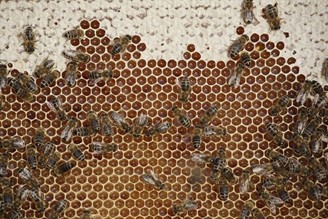PFAS in honey

Flanders: land of PFOS and honey
The PFOS contamination near the 3M plant in Zwijndrecht, Belgium has been dominating the news in the northern part of Belgium for the last 8 months. As there are a number of potential exposure pathways to PFOS (and PFAS in general) for bees, many beekeepers from the vicinity of the PFOS producing plant had their concerns about the food safety of their honey. In order to be able to answer the question if honey coming from beekeepers near a PFOS-contaminated zone is safe for consumption, a study was conducted by the Flanders Research Institute for Agriculture, Fisheries and Food (ILVO).
PFOS occurrence in honey: no direct link with PFOS production locations
The study involved the collection of honey samples from beekeepers near Zwijndrecht and Willebroek, two regions with PFOS contamination. In addition, honey samples from honeybees located further away (>10 km) from a known PFOS-contaminated zone were also checked for PFAS for comparison. All these honey samples were examined for PFOS and 21 other PFAS components.
Of the 4 PFAS compounds (PFOA, PFOS, PFHxS & PFNA) mentioned in the 2020 EFSA Scientific opinion, only PFOS was detected (in less than 10% of the samples) but without a direct link to a known contamination zones.
Alarming (?) levels of other PFAS
Striking is the frequent occurrence in honey of PFPeA (in 30 of 32 samples) and PFBA (in 26 of 32 samples). The compounds PFBS (in 8 of 32 samples) and PFHxA (in 5 of 32 samples) are only found in honey from bee stands located within 10 km of the 3M site in Zwijndrecht.
Conclusions: alertness and –again- more research required
Only 3 of 32 honey samples tested positive for PFOS, and those had no link to a known PFOS contamination zone. If the safety value of the EFSA standards of 2008 is used, the detected PFOS concentrations do not pose a problem to public health. Based on the stricter tolerance values mentioned in the EFSA scientific opinion of 2020, a food safety problem might occur in case of a large consumption of the most contaminated honey.
A similar study with analyses of beeswax should indicate whether there are problems with PFOS or PFAS contamination in beeswax. As a precaution, the reuse of beeswax from bee stands near known PFAS-contaminated sites for the production of wax foundations is not recommended for the time being, nor is the consumption of pollen from such bee stands. In addition, the potential toxicity of PFPeA, PFBA, PFBS and PFHxA also requires further study.
More on this ILVO study can be found on the English pages of the ILVO website. The extensive report of this study (in Dutch) can be found here.
EmConSoil coordinator
- Address
- Stationsstraat 110
2800 Mechelen
Route and accessibility - Telephone
- +32 15 284 284
